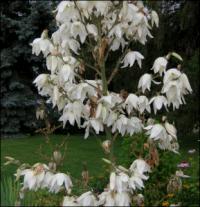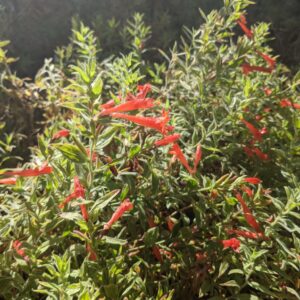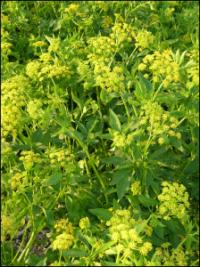Our Plants
Showing 585–587 of 587 results
-
Yucca filamentosa syn. Yucca americana Adam’s Needle, Silk grass Z 4-10
July – August flowers with translucent white bells, five feet high, out of a clump of spiky evergreen foliage.
July – August flowers with translucent white bells, five feet high, out of a clump of spiky evergreen foliage.
Size: 30" leaves - 5' flower x 3'
Care: full sun, moist well-drained soil. Drought tolerant
Native: New Jersey to Florida
Wildlife Value: symbiotic relationship with Yucca moth – its only pollinator is the Yucca moth and the Yucca is the only food source for the Yucca moth.
Awards: England's Royal Horticultural Society Award of Garden Merit; Cary Award Distinctive Plants for New England and Elisabeth Carey Miller Botanical Garden Great Plant Pick.IIn 1596 Gerard (1545-1612) named the genus Yucca from the incorrectly identified plant. He named it Iucca. Filimentosa from the Latin “filum” meaning “thread” because of the threads on the leaf margins. Colonists cut the leaves of Y. filamentosa to make thread. Indians used the root as an ingredient in bread, to make suds for cleaning and the leaf fibers to make clothes. For the Cherokee it cured diabetes and skin sores, induced sleep in people and drugged fish for an easier catch. One of earlier No. American plants sent to Europe – grew in Tradescant the Younger’s South Lambeth nursery in 1656. Both Gerard and Parkinson grew Yucca filamentosa in their personal gardens. Jefferson planted this in 1794 and called it “beargrass.” Grown at Elgin Botanic Garden, America’s 1st botanic garden, 1811.
-
Zauschneria garetii syn Epilobium canum ssp. garrettii Hummingbird trumpet, California fuchsia, Garrett’s Firechalice Z 5-9
Vibrant orange-red tubes in late summer, spreading by root, form a colorful groundcover.
Vibrant orange-red tubes in late summer, spreading by root, form a colorful groundcover.
Size: 12” x 18-24”
Care: sun to part shade in well-drained soil
Native: Kingston Mountains in CA, Utah, Idaho & Wyoming
Wildlife Value: Attracts hummingbirds, birds and butterflies, Deer and rabbit resistantCollected in Utah’s Big Cottonweed Canyon in 1906 by A.O. Garrett (1870-1948), prolific Utah planthunter.
-
Zizia aurea Golden alexanders Z 4-9
In spring, golden umbels
Tiny chartreuse-golden flowers, grouped in umbels, spring. Good cut flower.
Size: 30"x 24"
Care: full sun in moist to moist well-drained soil
Native: from New Brunswick south to Florida - west to Texas, Wisconsin native
Wildlife Value: Primary host for the Missouri Woodland and Black swallowtail butterfly caterpillars. Supports over 70 bee species.Meskwaki used the root to reduce fevers and the flower stalks to ease headaches. Collected by late 1700’s. Good cut flower.



